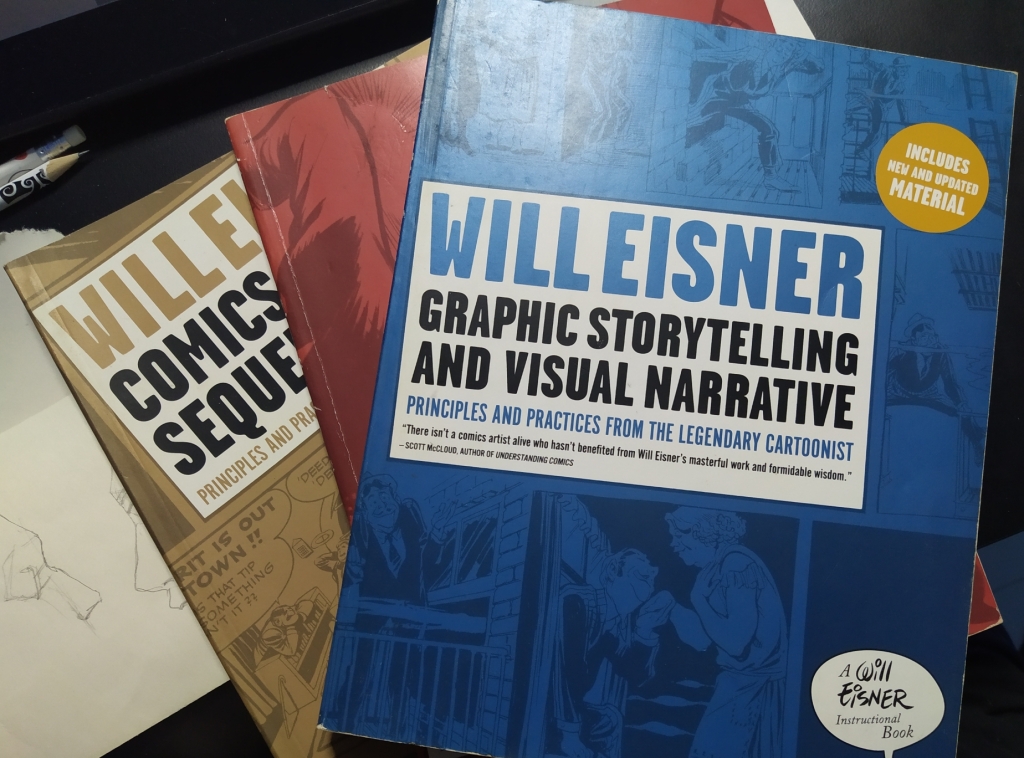It has been awhile since I wrote a art book review, (FFXIV Bozja grind stole so much of my lockdown time) so here I am. With the entire Will Eisner set, starting with Graphic Storytelling and Visual Narrative. He released this second but I am reviewing this one first as this feels more like proper introduction to Visual Storytelling then followed up by his first book going in-depth with comics.
This book really helps first time storytellers realize certain tropes and ways to tell a story, a how-to instruction wrapped in a story where the details of the how-to are more important and the story is just the vehicle for that message, etc.
If you want to start your first comic and have a hard time crystalizing aspects of what you want to do and how you want to do it, this book will definitely help clear up some mysteries, you will understand when I show some pages, this is not just a comic related book, it is a graphic storytelling and visual narrative book, delving into how certain mediums like films, tv and written books do narrative storytelling.
So, in both my non-instructional and instructional art book reviews, I don’t really want to give a score/rating system to the books but have categories in which I feel are important for an artbook to succeed.
For non-instructional art books, like say artbooks of movies, games, etc. I have certain categories to access them, for instructional/how-to books I have other categories.
Art books do take up a lot of space and if you don’t have a lot of space, its best to buy only the best of the best or what you yourself like.
The categories for instructional books are: Overview, Inspiration, Ease of Access (Beginner, Intermediate, Expert), Usefulness, Summary.
Overview: General, short, introduction of the book.
Inspiration: Does the book give a spark to light the artistic flames of creation or whatever, does the book inspire/make you want to draw and create your own things yourself.
Ease of Access: Certain books are only helpful to certain levels of artists, by this I mean technical skill, some books won’t make sense to beginners, others will be telling what experts already know, so starting from Beginner, to Intermediate, to Expert. Which level, the book caters to.
Usefulness: How useful the book is, does the book help to solve the problem you bought the book for.
Summary: Whether you should buy this book or not.
And now onto the review~
Overview: Will Eisner was born in Brooklyn and was creator of Wonder Man and the Spirit, the comic industry’s top annual awards, “The Eisners”, are named in his honour. He created a set of instructional books related to comics, in this he reveals how to construct a story and the basics of crafting a visual narrative with many great examples drawn by him.
Inspiration: This book really gives you that moment of “Oh! That story/comic I always liked is in a certain storytelling narrative, where there’s a really simple plot and its supported by astounding visuals so it becomes more of the visuals than the plot” You start to get to identify storytelling narrative tropes like that and that can help you frame your own story that you want to tell and thus inspire you further to define your work and start working on them.

Ease of Access: This book is definitely great for beginners to open their mind to what is visual storytelling, what does it entail, how different mediums handle them, etc. Its good for intermediates and experts to refresh too, if they are stuck on how to create another story.

Usefulness: Its really useful especially to understand more about the semantics and methods of storytelling, to broaden your mind and put into terms what story you are doing with good examples of narrative structure and just from these three pages you can tell how much care and use that the book has. It even has inserts and mentions of modern mediums that Will Eisner wanted inside to be as a modern a take on storytelling as possible.

Summary: Yes! Its not a huge book that takes up a lot of space and has good information to warrant keeping it. Spoiling the future two reviews by saying it will be worth getting the other two books as well. They are a great set of books that compliment/feed into each other.
Next two are: Will Eisner’s “Comics and Sequential Art” and “Expressive Anatomy For Comics And Narrative”
If you liked what you read, please consider supporting me on Patreon (monthly) or ko-fi (one time donations).
Stay safe~!
JR

